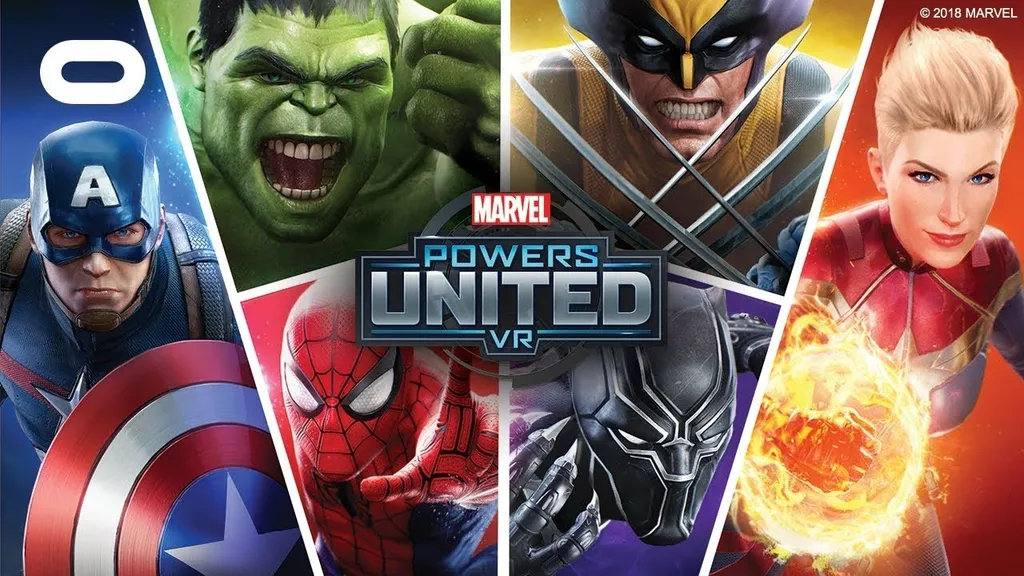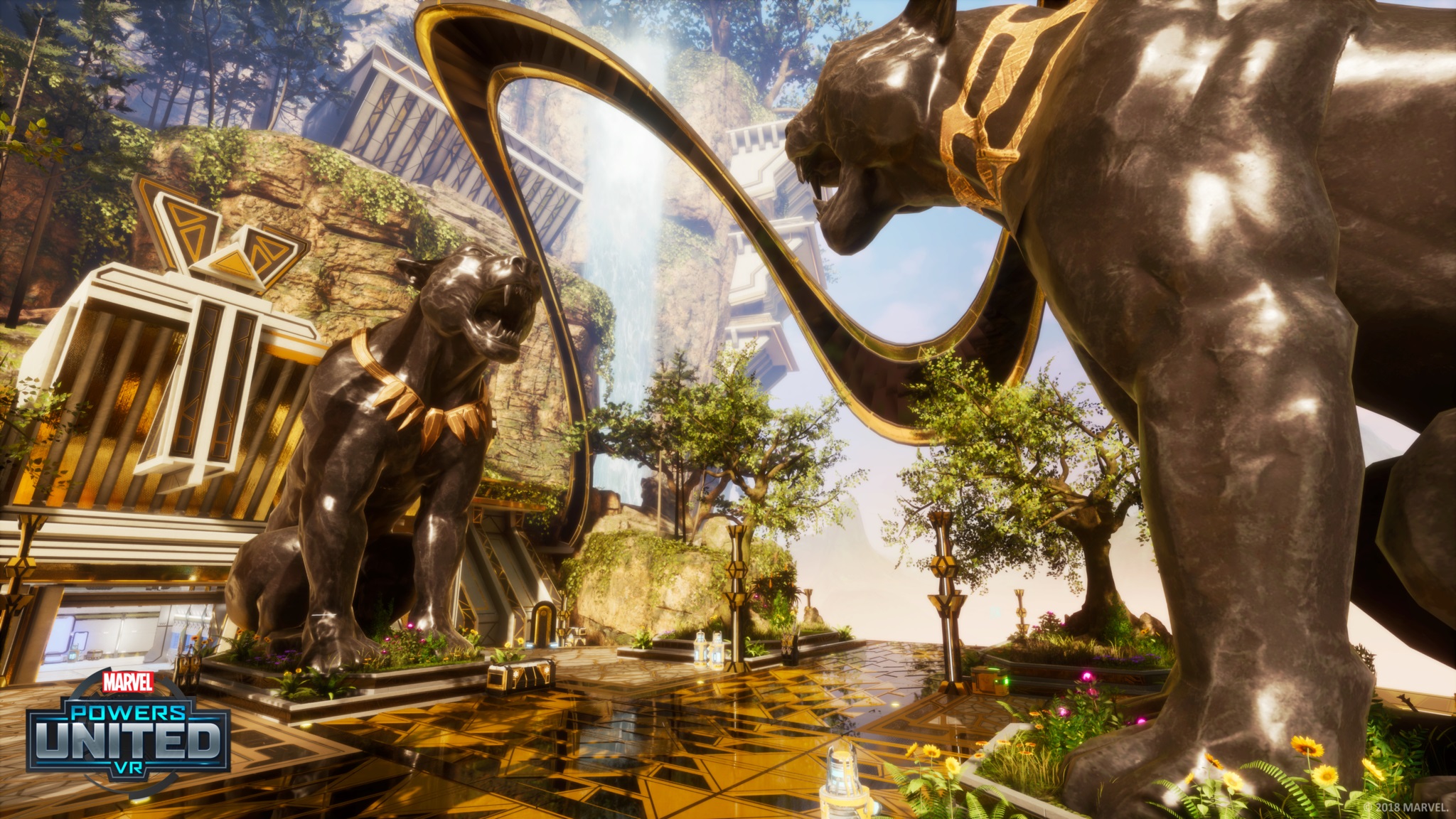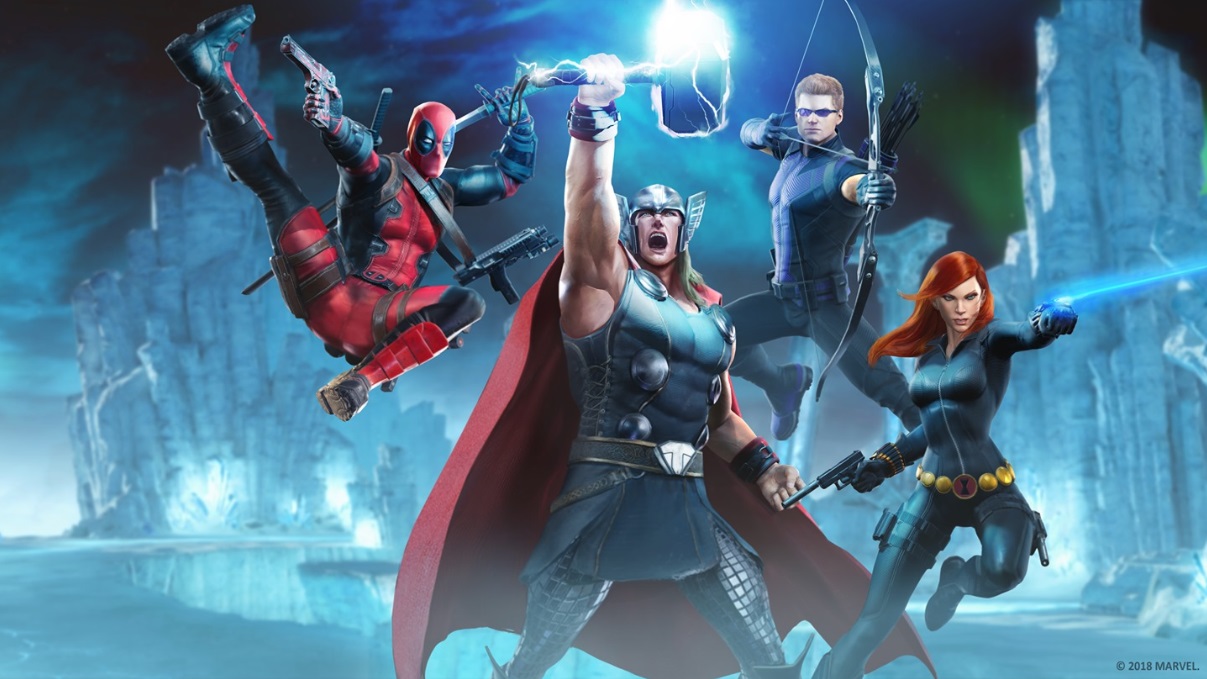I don’t envy Sanzaru Games. At first thought, the chance to adapt the weird and wonderful world of Marvel into an Oculus Rift game that turns anyone into their favorite superhero might seem like a golden opportunity for any developer. Smash like The Hulk, slash like Wolverine and swing like Spider-Man? What’s not to love? As is so often the case in VR, though, that’s all much easier said than done. Take the opening prologue of Marvel: Powers United VR, for example.
This bit of gameplay is one of the most giddy sequences you’ll see inside a headset this year; The Hulk leaps over your head before making a crater in the middle of a bus, Rocket Raccoon bursts through a wall guns blazing and Deadpool lectures Wolverine before they team-up and head into battle. Arguably the best moment in the intro, though, is when Spider-Man swings in from the skyline, somersaulting and leap-frogging his way across buildings. It’s elegant, effortless and a tantalizing tease that leaves you begging to slip on some web-shooters.
Here’s what actually playing as Spider-Man feels like:
Powers United gets a lot right, more than I thought it would, in fact. It is at times a riotous, bombastic explosion of comic book action in which Ultron robots are hurled across the room before being encased in ice, webbed up and shot to pieces. But it’s also a game that knows the limitations of its platform, and sets its own standards accordingly. There’s no web-swinging as Spidey, for example, and Hulk can’t leap over skyscrapers. Rather than honing in on what makes each of these heroes unique, you’ll find many of them adhere to a template that doesn’t really capitalize on their skillsets. With VR still in its infancy, these are very hard problems to solve and certainly not something I’d expect Sanzaru to have all the answers to, but there’s an undeniable feeling of everything being toned down from the big screen action of, say, the Marvel Cinematic Universe.
If you can look past that shortcoming along with a few others, though, Powers United still offers just enough to satisfy both VR and comic fans alike.
Immediate mention has to go to the game’s production values which are, frankly, second to none. Suiting up as your favorite hero and then staring down to see their costumes on your virtual body is elating; no detail has been spared in bringing these characters into VR, from the belts that strap Black Panther’s gadgets to his arms to the grimy details of Hulk’s toenails. I haven’t been this amazed to see my virtual-self since the first time I entered VR. It is a bit of a shame the dialogue doesn’t match it; every hero spouts out cheesy one-liners every three or four seconds that will have you turning down the voice overs ASAP.
No matter which hero you choose, though, the game’s four-player co-op action feels decidedly closer to a League of Legends-style multiplayer online battle arena (MOBA) more than it does any of the dedicated games these characters have enjoyed over the past few decades. There’s not a campaign as such; you instead cycle between missions that take place in relatively small arena-style levels, completing defensive objectives and holding off scores of enemies that are more interested in attacking what you’re guarding rather than yourself. Beat tougher baddies based on comic book villains and you’ll earn shards of the Cosmic Cube, which when assembled can be used to take on snap-happy Avengers boss, Thanos.
Powers United is very much a game intended to be played online (you even have to enter matchmaking before you can select the single-player mode with the aid of bots). To its credit, it’s one of the game’s key strengths. It’s a real thrill to see your friends gather round you as you bombard Magneto with laser beams and bullets, and parts of your missions will genuinely require you to talk through what roles everybody’s going to play. There are characters that have better defensive capabilities than others, and some can even fly, allowing you to cover more range. You’ll definitely want to strategize with friends to make sure you have the most effective team going into battle.
As the name suggests, Powers United wants to make you feel powerful, and thus the standard enemies are more bothersome flies than they are legitimate threats. In some respects, this works wonders; the testosterone-fueled bravado of picking up minions as The Hulk and tossing them to one side like action figures will have you beating your chest, while slicing your way through the hordes as Wolverine is every bit as empowering as you’d imagined it to be when you first picked up your Touch controllers. Some heroes rely on tried and true VR mechanics, like Hawkeye’s bow and arrow, while there’s perhaps a little too much focus on gun-slingers like Deadpool, Black Widow, Rocket, and Starlord. Even lesser-known characters like Iceman and Crystal earn their spots in the roster with unique skill sets, though.
Other characters don’t fair quite as well. Dr. Strange should be one of the most versatile and downright weird members of the cast, but his attacks are reduced to simple magical projectiles which are basically identical to Iceman, Captain Marvel and Storm. Captain America’s shield-slinging action might seem like a natural fit for VR, but in practice it’s awkward to wield, failing to capture the elegant precision seen when it’s lobbed on the big screen.
Black Bolt, meanwhile, feels like a wasted spot, especially when you consider you can’t use Rift’s microphone to utter his ear-shattering sonic voice. And, yes, as happy as we were to discover Spider-Man was playable, he’s a shadow of his true web-slinging self (though his ability to web baddies to walls is a lot of fun). Even with glaring omissions like Iron Man, I’d have happily elected for a smaller roster with characters that have more of their own identity.
Boss battles are a similar affair. Some of Marvel’s deadliest villains have been assembled here but, while they’re amazing to look at, actually fighting them feels messy. They’re damage sponges that won’t physically react to your attacks, robbing battles of any kind of cinematic flair. Rather than any kind of nuanced and unique attack strategy, each is simply defeated by keeping your distance, using ranged weapons and making sure to dash before they initiate their clearly-telegraphed attacks. Why isn’t Loki using his patented body-double trick? Why isn’t Storm’s lightning super effective against the Venom symbiote? It’s a far cry from the teamwork-based combat we usually see our heroes employ to overcome the odds in the movies and books.
Powers United’s biggest nemesis, though, is its repetition. Your main reason for returning to the game time and again is to build up 25 cosmic shards to take on Thanos. You usually get a shard for beating a boss, 1-3 of which appear in a level depending on performance, so you’re looking at approximately 13 successful battles to get to the final boss and, if you lose, you have to build them all back up again.
The problem is every single one of these missions unfolds in the exact same way, with three sections in which you defend smaller relays before one final push to defend a larger one. There’s really very little in the way of surprise in each mission and it meant the game’s main appeal for me was just trying out all 18 heroes. Once I had done that, I felt like I’d seen everything with little reason to come back.
The game really could have benefitted from better structure than the sort of free-for-all of content available right from the start. You can unlock new outfits and unexciting poses for your characters, but I would have liked to have seen a little more of a sense of progression, perhaps unlocking new powers for your characters or even keeping some of them locked away until you’d made your way through a certain number of levels.
Marvel: Powers United VR is a hard game to score, becuase its best characters make it feel like an 8/10 while the majority of cookie-cutter heroes bring it closer to 5/10. Ultimately it’s a little more of a muted take on the superhero VR genre than we were hoping. It’s carried by its best characters, heroes with truly unique abilities that evoke sheer blockbuster comic book joy you’ll keep coming back for. But much of its cast struggles to stand out from a set of templates that limit their capabilities and the repetitive mission structure and forgettable boss battles put a ceiling on the fun. In those ecstatic moments where you pop Wolverine’s claws, let loose Storm’s lightning or pound the ground as Hulk, though, Powers United VR packs just enough magic to keep true believers happy.
Marvel: Powers United VR releases for the Oculus Rift with Touch on the Oculus Home Store on July 26th for $39.99. Check out these official review guidelines to find out more about our process.
For more on Marvel: Powers United VR, make sure to check our detailed information dump and massively detailed Character Guide right here. Let us know what you think of the game if you’ve had a chance to play down in the comments below!





























